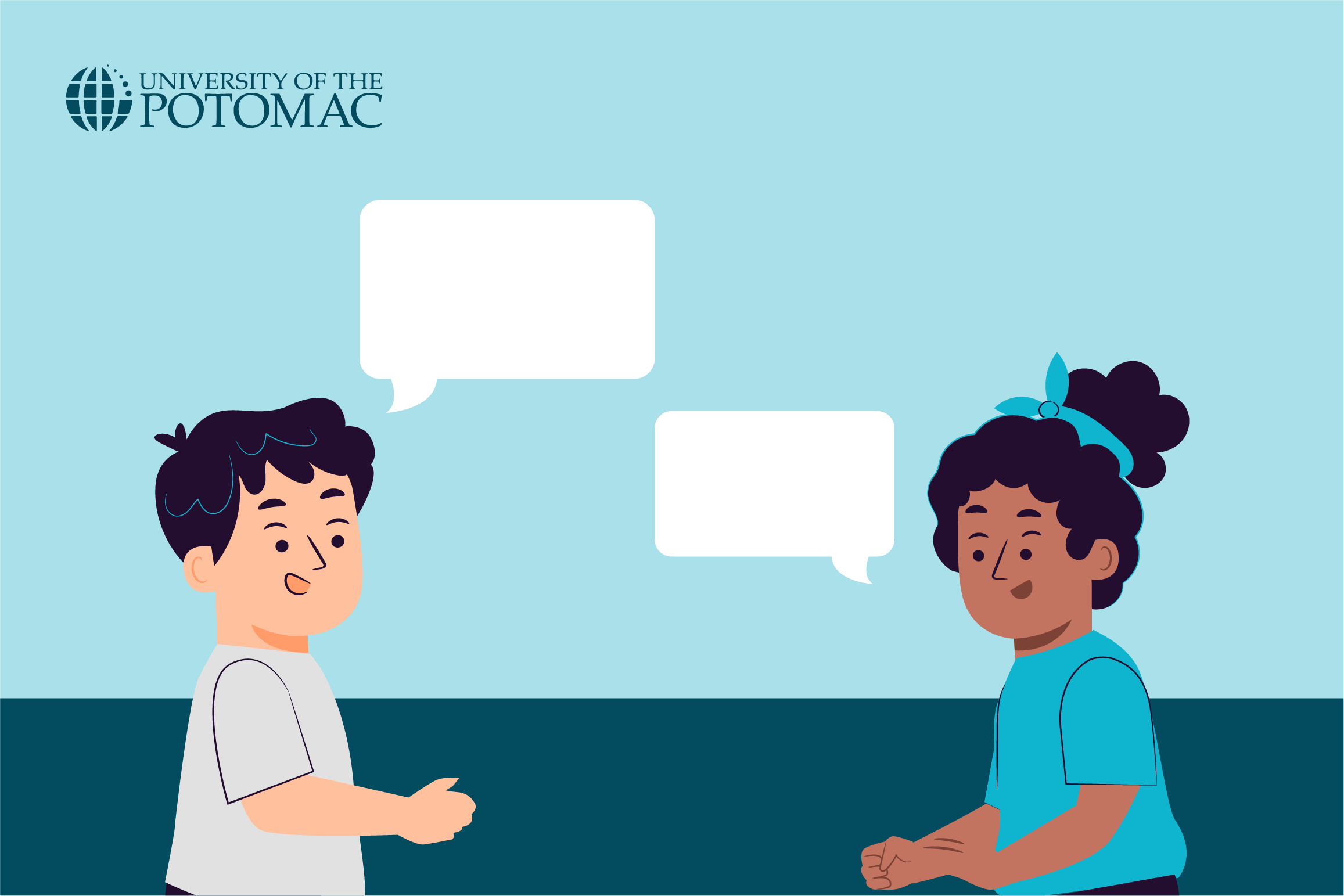Key Takeaways
- Language development in early childhood includes listening, understanding, speaking, and social communication, all of which build a foundation for future learning.
- Parental involvement, socioeconomic factors, and mindful screen use strongly influence how children acquire language skills.
- Practical experience combined with solid theory helps students effectively support and promote language growth in young children.
Language development in early childhood lays the groundwork for how children think, connect with others, and express emotions. From babbling to forming full sentences, each step helps shape their understanding of the world. Strong language skills not only support learning in school but also build confidence and improve social interactions.
In this blog, we will walk through the key stages of language development in early childhood, from infancy to preschool years. We will also share practical tips parents and caregivers can use to support a child’s communication skills naturally through everyday routines, play, and conversation.
What Is Language Development in Early Childhood?
Language development in early childhood is the process by which young children learn to understand and use language to communicate. It begins long before a child says their first word and continues as they grow, gradually picking up vocabulary, sentence structure, and the ability to express thoughts and emotions. This development forms a key part of how children learn to think, interact with others, and make sense of the world.
It is important to understand that language development is not only about speaking. It also includes listening to sounds, understanding words and gestures, interpreting tone and emotion, and using language appropriately in social situations.
For example, a toddler pointing at a toy or smiling when hearing a familiar voice is already using basic communication skills. These early forms of expression grow into more complex language abilities as the child’s brain, hearing, and social awareness continue to develop. Recognizing these different aspects helps parents and caregivers support a child’s overall communication journey.
Stages of Language Development by Age
Early childhood, from birth to age five, is a critical period because the brain is rapidly growing, forming strong neural pathways tied to language. This window shapes a child’s ability to understand, process, and use language effectively.
Birth to 12 months
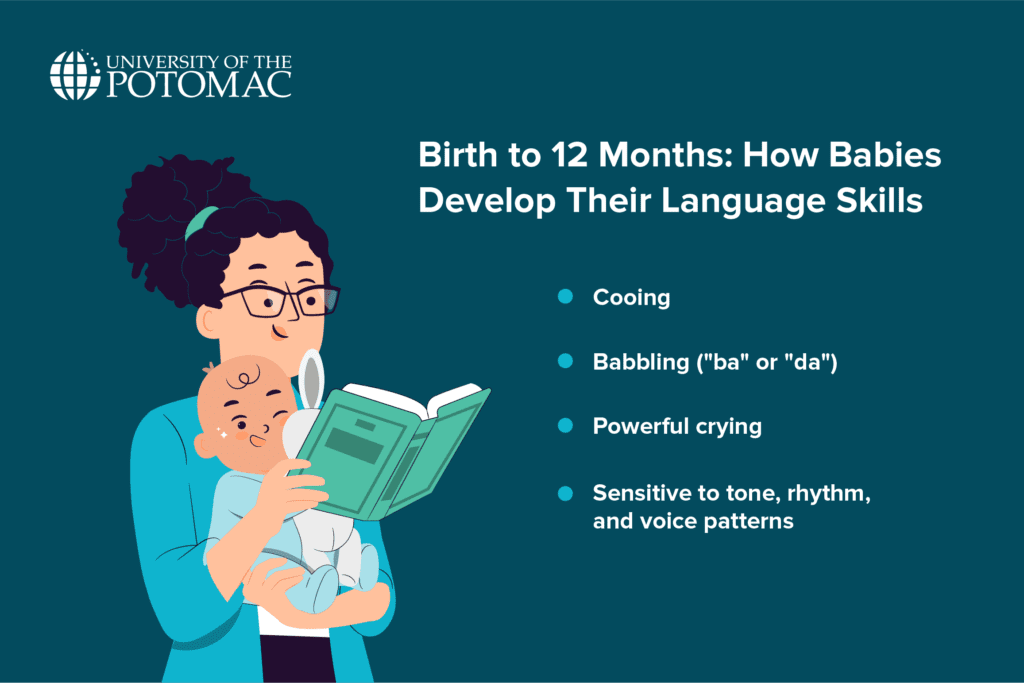
From birth to 12 months, babies go through key prelinguistic stages that form the base for later language use. Around 6 to 8 weeks, they begin cooing—soft vowel sounds that show early vocal play. By 4 to 6 months, this shifts into babbling, where babies experiment with sounds like “ba” or “da.”
Crying also becomes more purposeful. A hungry cry may sound different from one caused by discomfort, and caregivers quickly learn to tell the difference. Social behaviors like smiling and maintaining eye contact begin around 6 weeks, offering the first signs of connection and communication.
During this time, babies become highly sensitive to tone, rhythm, and the patterns of voice. They may calm down when hearing a gentle voice or get excited by a playful tone. Receptive language development takes the lead, even before words are spoken. By the end of the first year, many babies recognize their name, turn toward familiar voices, and respond to common sounds, laying a strong foundation for future speech.
Language learning activities at this age
To support language development during the first year:
- Talk to your baby often using a calm, expressive tone.
- Describe what you’re doing during daily routines like feeding or diapering to build word associations.
- Respond to your baby’s coos and babbles with smiles, gentle words, or playful imitation to keep the interaction going.
- Read simple board books with high-contrast images and repetitive phrases to build listening skills and attention.
- Singing lullabies or nursery rhymes can also help babies notice rhythm and sounds in speech.
- Using infant-directed speech, often called “motherese,” with its slower pace and exaggerated tones, naturally captures a baby’s interest.
12 to 24 months
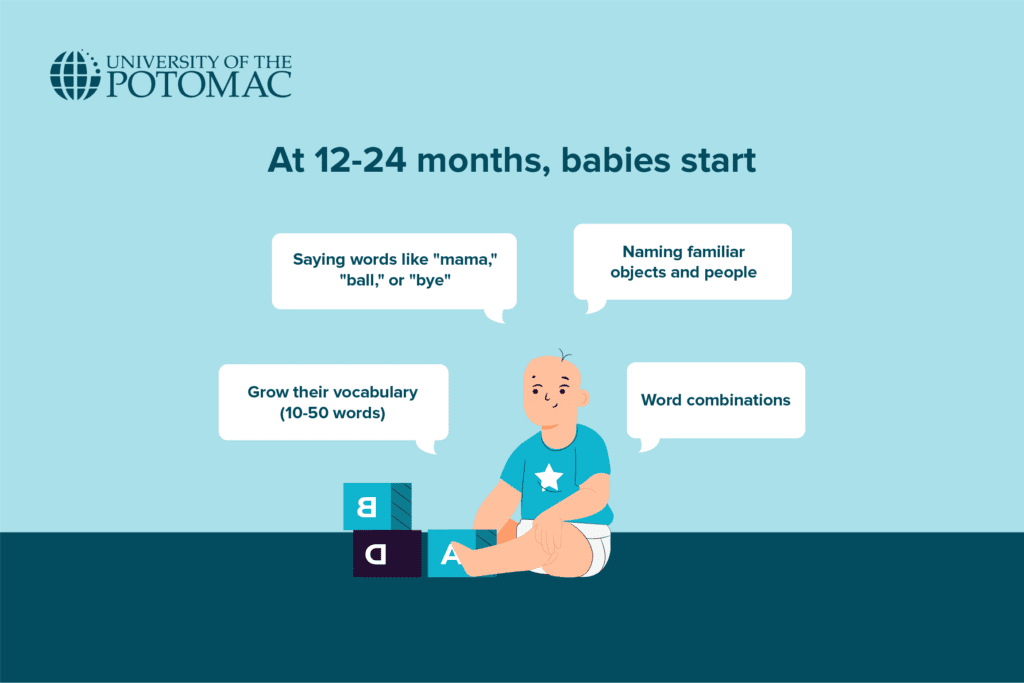
Between 12 and 24 months, toddlers move from making sounds to using real, meaningful words. Around their first birthday, many children begin saying simple words like “mama,” “ball,” or “bye.”
By 18 to 24 months, their expressive vocabulary typically grows to include 10 to 50 or more words. They start naming familiar objects, people, and everyday routines, such as “milk,” “dog,” or “bath.” During this stage, many children also begin combining two words into simple phrases like “more juice” or “daddy go,” marking a major step in language development.
Along with speaking, their understanding improves as well. They can often follow simple directions like “come here” or answer basic questions with gestures or short replies. Toward the end of this stage, many children experience a “vocabulary burst,” also called a “word spurt,” where they suddenly pick up and use new words at a much faster rate. This rapid growth in word use reflects major progress in how they process and express language.
Language learning activities at this age
To support language development between 12 and 24 months:
- Name everyday objects during routines, like “shoes on” or “cup of milk,” to build word recognition.
- Read simple books with repetition and labeled pictures to encourage naming.
- Play imitation games such as making animal sounds or pointing to body parts.
- Sing interactive songs like “If You’re Happy and You Know It” that involve actions to link words with movement.
- Offer choices using words, such as “apple or banana,” to prompt responses.
- Expand on what your toddler says by adding detail—if they say “car,” respond with “Yes, a red car!”
- Use parallel talk by narrating their actions to give them more language input in real time.
2 to 3 years
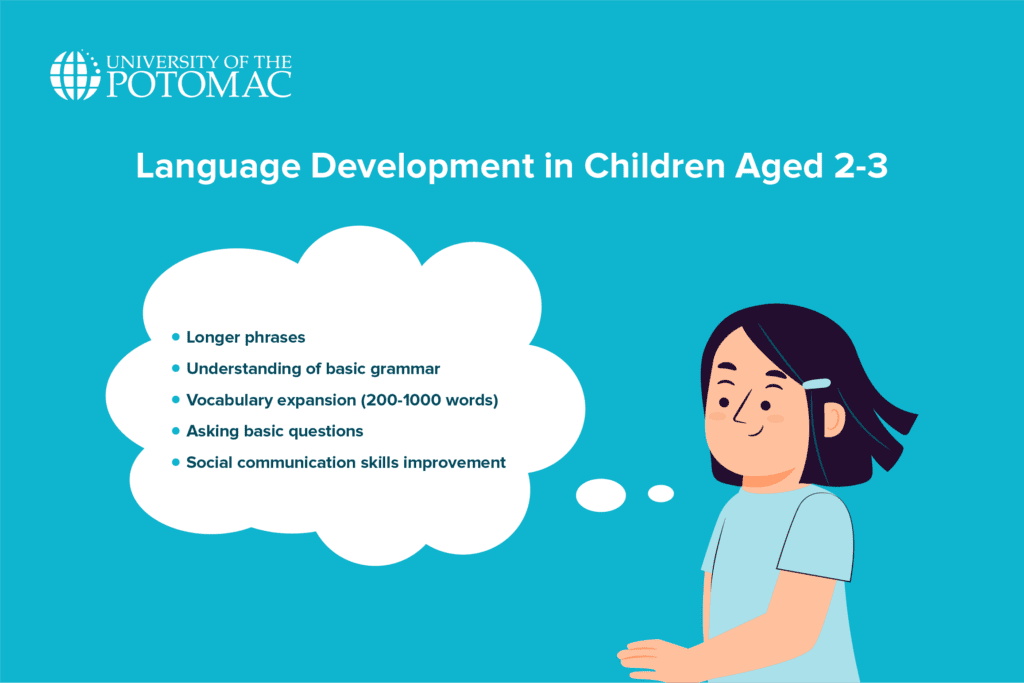
Between the ages of 2 and 3, toddlers make big strides in language development. They move from using short two-word phrases to forming longer ones with three to five words, such as “I want juice” or “go to park.”
During this stage, they begin to understand basic grammar. You may hear them use pronouns like “me” or “you,” simple plurals like “dogs,” and common verbs like “run” or “eat.” Vocabulary expands quickly, often reaching between 200 and 1,000 words by age 3, depending on how much language they hear and how they interact with others.
Children at this age begin to ask basic questions, starting with “what” and “where,” showing curiosity and a desire to learn. They also start narrating simple events, such as “baby cry” or “I eat apple,” to share experiences. Their social communication, or pragmatic language, also improves. They begin to take turns in conversation, respond to others, and make simple requests, which helps build strong communication habits.
Language learning activities at this age
To help children aged 2 and 3 develop their language capabilities:
- Read interactive books that invite repetition or ask simple questions, like Brown Bear, Brown Bear.
- Play pretend games such as kitchen, doctor, or store to encourage sentence use and role-play dialogue.
- Ask open-ended questions like “What are you doing?” to spark conversation.
- Sing songs with motions and repetition, such as Wheels on the Bus or Old MacDonald, to strengthen word recall.
- Expand your child’s speech by repeating what they say and adding more detail, turning “dog run” into “Yes, the dog is running fast.”
- Use picture cards or everyday objects for sorting, naming, and simple storytelling activities.
3 to 5 years
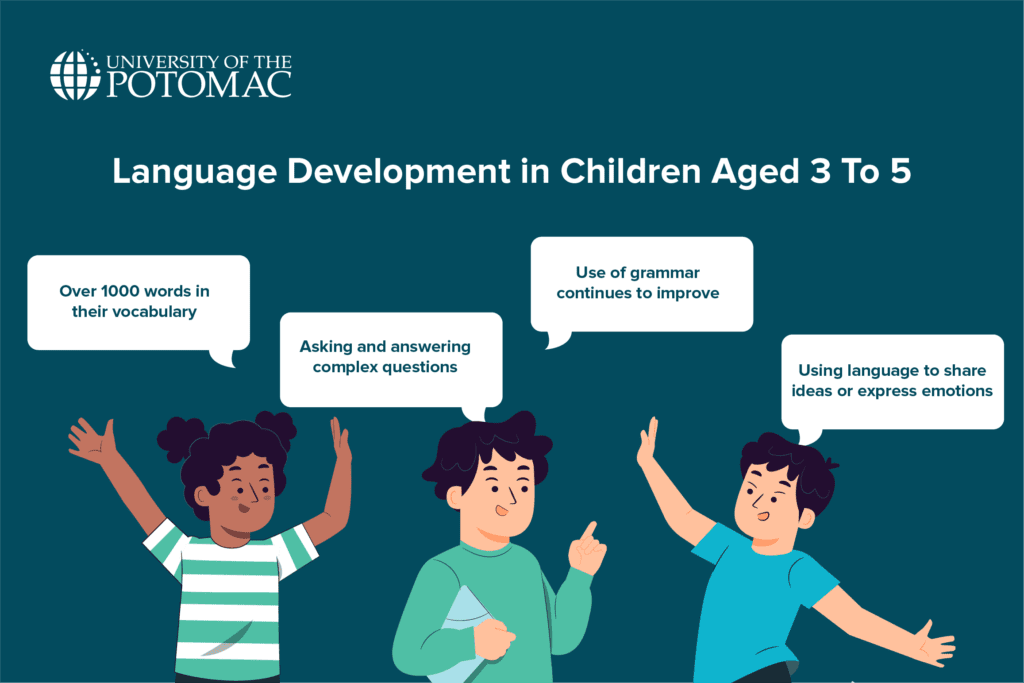
By ages 4 to 5, many children use over 1,000 words and begin forming more complete, detailed sentences. They can ask and answer more complex questions like “why,” “how,” and “when,” and often enjoy telling simple stories with a clear beginning, middle, and end.
Their use of grammar continues to improve, including using past and future tenses more accurately. While most sounds are easier to understand at this stage, some pronunciation differences are still typical.
Language also becomes more connected to thinking and emotions. Children begin using words to solve problems, express feelings, and engage in imaginative play. They might explain how they’re feeling, talk through a plan, or act out scenarios during play.
This stage of language development supports school readiness and social confidence, as children start using language to share ideas, ask for help, and explore the world around them in more meaningful ways.
Language learning activities at this age
To support language development between ages 3 and 5:
Interested in pursuing a degree?
Fill out the form and get all admission information you need regarding your chosen program.
This will only take a moment.
Message Received!
Thank you for reaching out to us. We will review your message and get right back to you within 24 hours.
If there is an urgent matter and you need to speak to someone immediately you can call at the following phone number:
- We value your privacy.
- Read picture books together and ask guiding questions to help with comprehension and sequencing.
- Encourage dramatic play with roles like teacher, shopper, or doctor to build dialogue skills.
- Show-and-tell activities help boost confidence and sentence structure.
- Introduce new words during group play or crafts, repeating them in context.
- Play rhyming games or sing songs to strengthen phonological awareness.
- Use pictures or hands-on activities to prompt describing and predicting—ask children to explain what’s happening or guess what might come next.
Factors That Influence Language Development
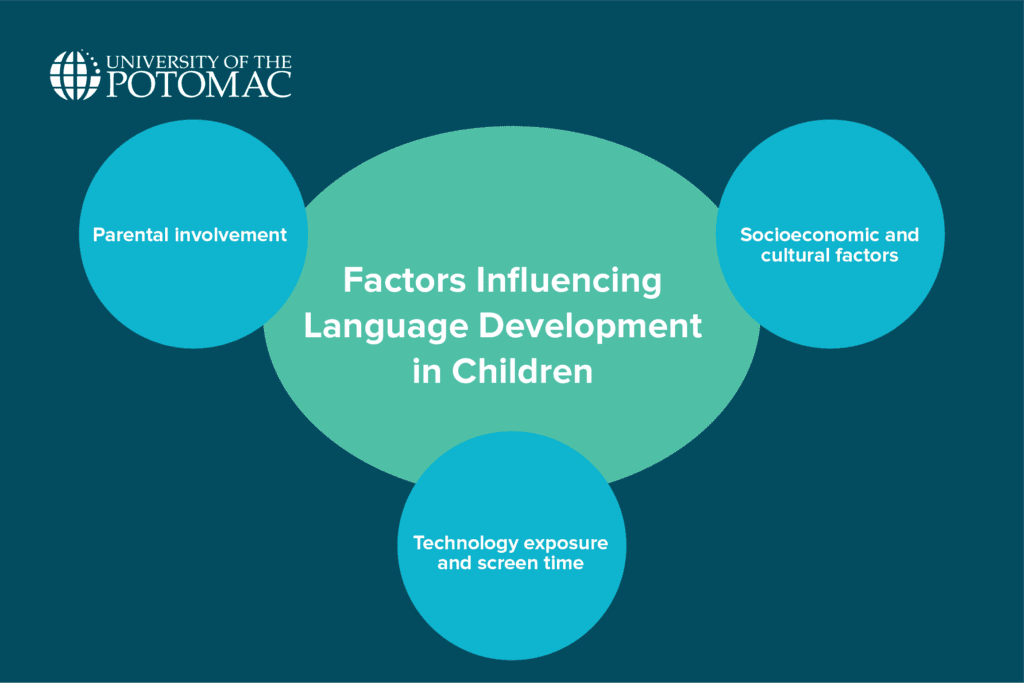
While language development generally follows predictable stages, each child’s progress can vary. Factors such as environment, caregiver interaction, exposure to technology, and individual temperament all influence how quickly and richly language skills grow.
Parental involvement
Frequent, responsive verbal interaction from parents or caregivers in language development.
One of the most effective methods is “serve and return”—when a child makes a sound, gesture, or word, and the adult responds meaningfully. This back-and-forth method helps children learn that communication is a two-way process. It also teaches them how words connect to feelings, actions, and people.
When caregivers are warm and consistent, they create a safe space for children to take language risks, such as trying new words or asking questions. Emotional security, combined with active engagement, builds confidence and accelerates language growth.
Socioeconomic and cultural factors
Socioeconomic status (SES) can strongly affect a child’s language development, too. Families with higher SES often have more access to books, learning materials, and time for enriching conversations. In contrast, lower-SES families may face time constraints, work demands, or limited resources that reduce adult-child verbal interaction.
Early education opportunities also vary by SES, influencing structured language exposure. Researchers have identified a “word gap,” where children from higher-SES homes by age 3 than those from lower-SES homes.
Cultural values and communication styles also shape how and when children are encouraged to speak, listen, and express themselves.
Technology and screen time
Excessive or passive screen time, especially in children under age 2, to delayed language development.
Watching videos without interaction doesn’t provide the social feedback children need to connect words with meaning. However, when screens are used intentionally, such as video chatting with relatives or exploring educational apps together, they can support language learning.
It is recommended that children under 18 months except for video calls. For toddlers and preschoolers, screen time should be limited, high-quality, and ideally shared with an adult.
The key concern is that screen time often replaces live conversation, which is essential for developing expressive and receptive language skills. Still, when guided by an adult, technology can be a valuable learning tool. Digital flashcards, storytelling apps, or videos that prompt discussion can enrich vocabulary and support early literacy when used thoughtfully and in moderation.
How to Improve Language Development Skills
To improve supporting language development in children, students should start by building a strong theoretical foundation. This means studying key language development theories from experts like Vygotsky, Skinner, and Chomsky.
Understanding important concepts such as language milestones and the structure of language, including phonology (sounds), syntax (sentence structure), and pragmatics (social use of language), helps create a solid base for practical work.
During practicum or field placements, active observation is essential. Students should learn to spot both typical and delayed language behaviors by using checklists or assessment tools to track children’s progress over time.
Interactive teaching techniques also play a big role in supporting language growth:
- Modeling descriptive language shows children how to express themselves.
- Asking open-ended questions encourages thinking and speech.
- Finally, promoting back-and-forth conversations in groups or one-on-one settings helps children practice real communication.
These skills together prepare students to effectively support language development in young children.
Conclusion
Language development in early childhood is crucial for a child’s growth in thinking, emotions, and social skills. Understanding key stages—from babbling as infants to forming sentences by age five—helps caregivers and educators support this journey. Parental involvement, socioeconomic factors, and mindful technology use all influence how children learn language.
For students eager to build their skills, gaining a solid foundation in theory and practice is essential. The Early Childhood Development BS program at University of ̽����ѡoffers hands-on experience and expert guidance to prepare you for a rewarding career. Join ̽����ѡto make a real difference in children’s lives through proper language development.
Frequently Asked Questions
What is the difference between speech and language development?
Speech development is about producing sounds and words, while language development includes understanding and using words, gestures, and social communication.
How can bilingualism affect early language development?
Bilingualism may slow early vocabulary in each language but ultimately enhances cognitive flexibility and overall language skills.


